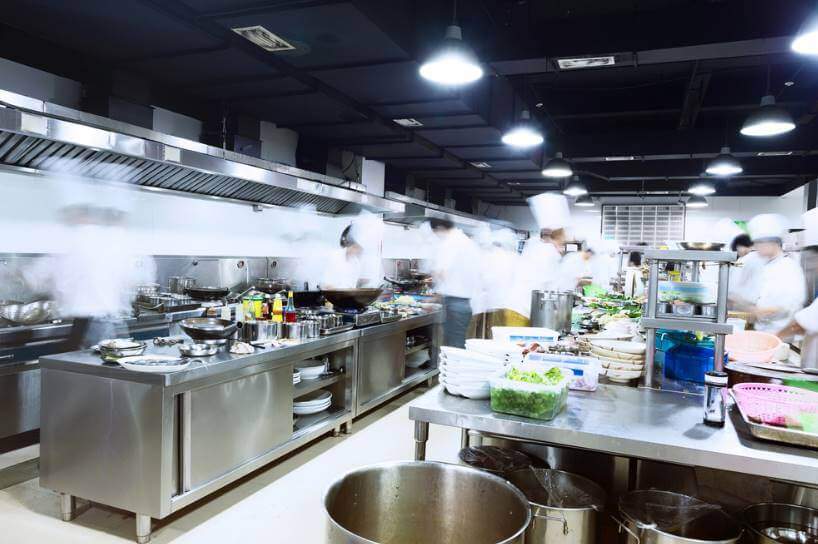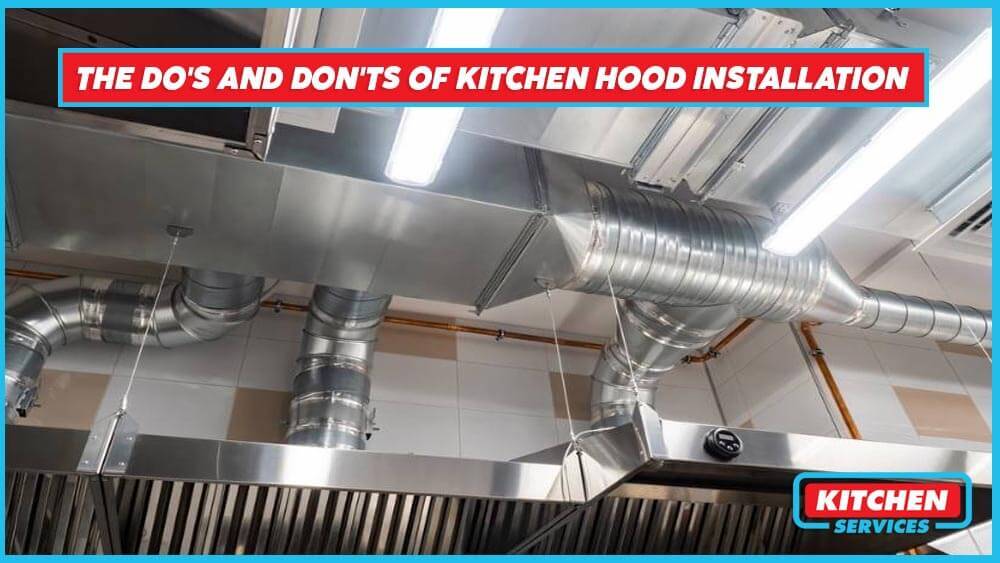Range hood installation is not an easy task. However, if you are a well-informed person who carries a solid foundation of how these things work in the kitchen, then it might become easier for you. After considering tons of factors like usability factor, placement, the area available, etc.
Without doing your homework if you land into the store and buy the most extravagant version of the kitchen hood, it might backfire. Because you need a model that fits well in your kitchen.
Once you have gotten your hands on the right model of the kitchen hood system, next is the installation process. Before starting with that, there are certain things you need to keep in mind. For instance:
- Within 24 hours of receiving the hood, make sure to unbox the vent hood for any damages.
- Ensure that the exhaust hood consists of all the parts, and that too in a good condition.
- Before proper installation, plug in your vent hood to check if it functions properly.
How to Install a Vented Range Hood in Your Kitchen?
When installing a range hood for your kitchen, it’s important to choose between ducted range hoods and ductless range hoods. For proper ventilation, installing a vented range hood is ideal, as it removes smoke and odors from the kitchen. The process typically involves cutting a vent hole in the exterior wall or opting to vent through the roof. To begin the installation, you may need drill bits to cut a hole for the range hood vent and run electrical wires using wiring connectors. During hood installation, a vent cap should be installed to cover the exterior opening. If you’re not comfortable with tasks like drilling a hole, handling electrical wires, or managing the cubic feet of airflow, it’s worth hiring a professional to ensure everything is done safely and correctly.
Do’s and Don’ts of Kitchen Hood Installation

The Do’s of Kitchen Range Hood Installation
- It is advisable to vent vertically via the roof of your kitchen. In case, venting directly above the hood is not possible then vent through the sidewall.
- Keep 36-42” for venting purposes over the BBQ grill.
- Keep 28-36” in between the bottom of the range hood and the top of the cooking surface.
- Make use of metal HVAC ducting or galvanized steel only.
- To achieve effective performance, use as few elbows as possible. That too with no more than three 90° elbows.
- Make use of caulking for sealing exterior openings that are around the cap.
- Make use of HVAC tape for sealing joints present in the vent system.
- Do prepper cleaning of duct to ensure effective airflow.
The Don’ts of Kitchen Range Hood Installation
- Never reduce the duct size.
- Never use a flexible Duct as it will create friction for the airflow causing it to make noise and reduce its efficiency. Use plastic ducting instead.
- Don’t terminate the range hood system into an enclosed space.
- Avoid dead-end to back-vent.
- Avoid using screens on roof jacks or wall caps. This reduces the airflow by around 20-50%.
- Never use plenum boxes.
- Avoid using roof jacks and wall caps with gravity dampers.
Despite knowing the above-mentioned Do’s and Don’ts, people still make some of the silliest yet most common mistakes while the kitchen exhaust hood installation.
For your ease, we have gathered some of those common mistakes for you to avoid.
Common Mistakes to Avoid While Vent Hood Installation
- Check Installation Height: Many people avoid going through the boring booklet that comes with a range hood. This is the biggest mistake one can make. Thoroughly go through the range hood manufacturer’s recommendations. The installation height can vary from one model to another. You cannot rely on the average estimate. So look for it in the guide.
- Unstable Electrical Connection: Usually people forget to carefully inspect their electrical connection before setting it up. This is a major mistake as it can have an impact on your Hood installation. For instance, you did not check your electrical connection before installation. Turns out, you had an unstable supply of electricity which is not letting your hood system function. Since you are unaware that the problem is with your electric supply, you assume that the range hood is faulty.
- Avoid Sharing the Electrical Lines: Sharing electrical lines especially when operating a vent hood system is never a good idea. Most people do this and cause electrical circuits. So avoid sharing the electrical lines of heavy appliances.
- Lack of Space: Most people do not properly measure the space they are going to install their kitchen exhaust hood. The placement area should be large enough so that it can accommodate your range hood without causing any problem.
- Inspect on Receiving: Commercial range hood buyers would always want to invest in exhaust hoods of well-reputed companies. This gives them a sense of reliance and they don’t inspect their unit at the time of receiving. This makes you go through the whole process officially. It will be time-consuming and might affect your restaurant’s service.
Kitchen Services provides competitive prices and high-quality Kitchen hood installation services in Los Angeles and around. Not only that, we also provide commercial hood cleaning and repair. Contact us today for effortless installation.
The Do’s and Don’ts of Range Hood Installation FAQs
Can you install a range hood without a vent?
Yes, you can install a range hood without a vent. This is called a ductless or recirculating range hood. It filters the air through charcoal filters and then releases it back into the kitchen. It’s a good option if venting to the outside is not feasible.
Can you install range hood vent through roof?
Yes, you can install a range hood vent through the roof. This method is suitable if wall or ceiling venting is not possible. Make sure to use a proper roof cap and seal the installation well to prevent leaks.
How to install exhaust fan in kitchen?
To install an exhaust fan in the kitchen:
- Choose a suitable location for the fan.
- Cut a hole in the wall or ceiling for the fan.
- Install the fan according to the manufacturer’s instructions.
- Connect the wiring and ensure proper ventilation through the ductwork.
- Seal any gaps around the installation.
How to vent a kitchen exhaust hood?
To vent a kitchen exhaust hood:
- Choose between wall, ceiling, or roof venting based on your kitchen layout.
- Install ductwork from the range hood to the chosen venting location.
- Ensure the ductwork is properly insulated and sealed to prevent leaks and energy loss.
- Install a vent cover or cap outside to protect from weather and pests.
How to install ductwork for range hood?
To install ductwork for a range hood:
- Plan the route from the hood to the outside vent.
- Cut holes as needed for duct entry and exit points.
- Assemble and connect the ductwork, ensuring all joints are sealed.
- Secure the ductwork in place with brackets and fasteners.
- Insulate the ductwork if necessary to prevent condensation and energy loss.
How to install a range hood vent?
To install a range hood vent:
- Choose the venting method (through wall, ceiling, or roof).
- Cut an opening for the vent if necessary.
- Attach the ductwork to the range hood and route it to the vent location.
- Secure the vent cover or cap outside.
- Ensure all connections are sealed and secure.
How to install a range hood vent through ceiling?
To install a range hood vent through the ceiling:
- Choose a location for the vent and mark the spot on the ceiling.
- Cut a hole in the ceiling for the ductwork.
- Route the ductwork from the range hood to the hole in the ceiling.
- Install a ceiling cap or vent cover to finish the installation.
- Seal all connections to prevent leaks.
How to install a range hood vent through the wall?
To install a range hood vent through the wall:
- Select the location for the vent and mark it on the wall.
- Cut a hole through the wall for the ductwork.
- Route the ductwork from the range hood to the wall opening.
- Install a wall cap or vent cover outside.
- Seal the ductwork and wall opening to prevent leaks.
How to wire a range hood?
To wire a range hood:
- Turn off the power supply to the kitchen.
- Follow the manufacturer’s wiring diagram.
- Connect the range hood’s wires to the corresponding wires in the junction box using wire nuts.
- Secure all connections and ensure they are properly insulated.
- Mount the range hood and restore power.

